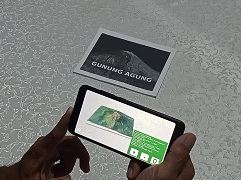GIS and Augmented Reality for learning
Author: Rakhmat Jaya Lahay, Indrawan, Mohamad Fachri Bokingo, Merlin Lauhi, Puspita Rahmat
The combination of geospatial technology and augmented reality can be a tool in learning volcano morphology. These devices can facilitate user interaction with hard-to-reach objects such as volcanic objects. GIS is a technology for processing data that has spatial attributes, such as volcanic objects. The 3-dimensional shape of volcanic objects can be easily made with geospatial technology. Meanwhile, augmented reality technology can help users interact with virtual objects in the real world. Through the integration of these two technologies on mobile devices, volcanic geographic objects can be projected virtually in the real world.

Read more at https://jurnal.unimed.ac.id/2012/index.php/geo/article/view/43460
See the simulation at https://youtu.be/i6iArXh9GKU
(RJL)
EPUB Digital Module
Authors: Merlin Lauhi, Sri Maryati, Rakhmat Jaya Lahay
The advancement of information technology in the era of the 4th industrial revolution has prompted the educational sector to embrace digital media in the process of learning. The development of digital modules undoubtedly requires technological tools capable of effectively packaging content to support students' digital literacy. Consequently, the development tools for digital modules and the formatting of module publications have become crucial considerations. This research aims to develop digital modules in EPUB format using open-source software. The ADDIE model (Analysis, Design, Development, Implementation, Evaluation) is adapted for the development of these digital modules. Overall, the research results indicate that the study underwent validation processes by subject matter, media, and instructional experts, achieving a significantly high validation score. Furthermore, students' responses also displayed positivity with an average percentage falling within the "Very Good" category. The digital module can be effectively utilized as a learning medium within educational institutions to bolster students' digital literacy.
